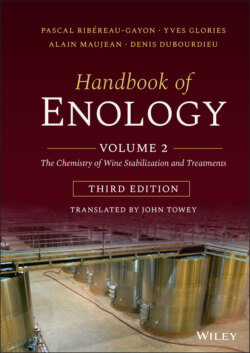Читать книгу Handbook of Enology, Volume 2 - Pascal Ribéreau-Gayon - Страница 62
2.5.3 Substituted Acid Ethyl Esters
ОглавлениеShort‐chain substituted acid ethyl esters exhibit special behaviors and have a particularly significant sensory impact. Recent studies (Pineau et al., 2009; Lytra et al., 2012, 2013, 2014, 2015), supported by older literature (Ribéreau‐Gayon et al., 1982; Guth, 1997), have established that some of these esters are involved in the fruity aroma of red wines. In contrast with most linear fatty acid ethyl esters produced during alcoholic fermentation, these substituted esters increase in concentration during tank or barrel aging and at the beginning of bottle aging. It seems that these compounds are produced by alcoholic fermentation initially and then subsequently via a chemical pathway involving esterification of substituted acids, which are themselves produced during alcoholic fermentation (Diaz‐Maroto et al., 2005; Lytra et al., 2017).
TABLE 2.5 Changes in Fatty Acid Ester Concentrations (in μmol/l) Depending on the Aging Time at 25°C and at Two Different pH Values (Garofolo and Piracci, 1994)
| Compounds | pH = 3.00 | pH = 3.50 | ||||||
|---|---|---|---|---|---|---|---|---|
| 0 months | 2 months | 5 months | 29 months | 0 months | 2 months | 5 months | 29 months | |
| Hexyl acetate | 1.90 | 1.20 | 0.00 | 0.00 | 1.70 | 1.50 | 0.40 | 0.00 |
| Isoamyl acetate | 36.60 | 13.30 | 3.10 | 0.40 | 36.50 | 20.60 | 14.00 | 2.50 |
| 2‐Phenylethyl acetate | 11.00 | 2.40 | 0.50 | 0.50 | 4.80 | 3.40 | 2.60 | 0.88 |
| Ethyl hexanoate | 12.20 | 8.70 | 6.40 | 4.30 | 11.00 | 8.80 | 8.40 | 4.60 |
| Ethyl octanoate | 9.30 | 9.00 | 7.40 | 6.40 | 5.70 | 5.50 | 5.50 | 3.69 |
| Ethyl decanoate | 2.70 | 3.40 | 3.10 | 2.00 | 1.20 | 1.20 | 1.40 | 0.79 |
Their sensory importance is based not so much on their direct impact as on their ability to regulate the fruitiness of red wines, both in terms of its complexity and its intensity, in particular via perceptive interactions with other compounds (Pineau et al., 2009; Lytra et al., 2012, 2013, 2014, 2015; Cameleyre et al., 2017).
